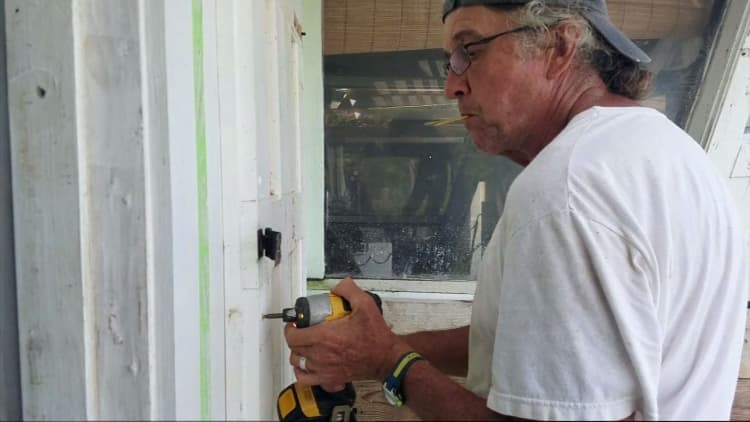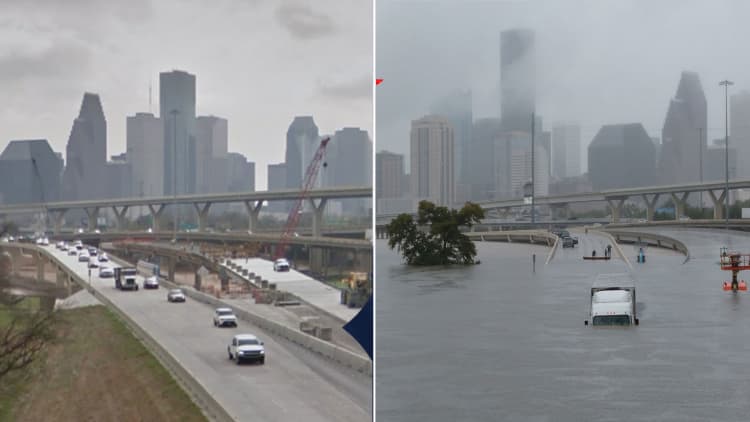
Hurricane Irma, one of the most powerful Atlantic storms in a century, churned across northern Caribbean islands on Wednesday with a catastrophic mix of fierce winds, surf and rain, en route to a possible Florida landfall at the weekend.
While Irma's trajectory is still uncertain, the storm has grown to the strongest Atlantic hurricane outside of the Caribbean Sea and Gulf of Mexico in the U.S. National Hurricane Center's records, the NHC said.
The eye of Irma, a Category 5 storm packing winds of 185 miles per hour, passed over the island of Barbuda early Wednesday morning and moved northwest over St. Martin, an island east of Puerto Rico, the U.S. National Hurricane Center in Miami reported. The storm's northern eyewall pounded the island of Anguilla, the NHC reported, and is currently moving west-northwest about 90 miles east of San Juan, Puerto Rico.
Irma could make landfall in south Florida this weekend, and the NHC issued a warning for the state to "monitor the progress" of the storm, while noting that "it is too soon to specify the location and magnitude of these impacts."
"We are hunkered down and it is very windy ... the wind is a major threat," said Garfield Burford, the director of news at ABS TV and Radio on Antigua, who was caught when the storm passed over the island. "So far, some roofs have been blown off." The government of Antigua has since discontinued the hurricane warning.
Most people who were on Antigua and Barbuda were without power and about 1,000 people were spending the night in shelters in Antigua, according to Burford.
"It's very scary ... most of the islands are dark so it's very, very frightening," he said.
The NHC said the "core" of Hurricane Irma is "battering the Virgin Islands," and will cause water levels to rise 7 to 11 feet above ground over most of the islands if the peak surge occurs at high tide.
The eye of the hurricane already passed over Barbuda, an island with a population of about 1,600 people, according to ABS radio. The NHC also issued a hurricane warning for the north coast of Haiti on Wednesday morning.
"All hearts and all prayers and all minds go out to the Barbudans at this time because they experienced the full brunt," a radio host said on the station early on Wednesday. Public relations professional Alex Woolfall said on Twitter he was hiding underneath a concrete stairwell as the storm neared St. Martin.
"Still thunderous sonic boom noises outside and boiling in stairwell. Can feel scream of things being hurled against building," he said. "Okay I am now pretty terrified so can every non-believer, atheist & heretic please pray for me."
The amount of damage and the number of casualties were not known early on Wednesday. A 75-year-old man died while preparing for the storm in Puerto Rico's central mountains, police said.
Several other Leeward Islands, including Anguilla, Montserrat, St. Kitts and Nevis, as well as the U.S. and British Virgin Islands, Puerto Rico and the Dominican Republic were under a hurricane warning.
"Preparations to protect life and property should be rushed to completion," the Hurricane Center said, warning that Irma "will bring life-threatening wind, storm surge and rainfall hazards" to those islands.
Puerto Rico's vulnerable energy infrastructure could leave the island without power for up to three months, depending on the direction the storm travels, according to Spanish-language news service EFE, which cited the country's state-owned energy agency.
Along the beachfront of Puerto Rico's capital, San Juan, work crews scrambled to cover windows with plywood and corrugated metal shutters along Avenida Ashford, a stretch of restaurants, hotels and six-story apartments.
"I am worried because this is the biggest storm we have seen here," said Jonathan Negron, 41, as he supervised workers boarding up his souvenir shop.
President Donald Trump assured Americans via Twitter that he is "watching hurricane closely. My team, which has done, and is doing, such a good job in Texas, is already in Florida."
Trump approved declarations of emergency in Florida, Puerto Rico and the U.S. Virgin Islands on Wednesday, and ordered FEMA and the Department of Homeland Security to direct relief efforts for the storm.
Republican Gov. Rick Scott declared a state of emergency across the entire state of Florida on Monday, and suspended all state tolls in order to ease preparedness and evacuation efforts.
"In Florida, we always prepare for the worst and hope for the best," Scott said in a news release on Monday, "and while the exact path of Irma is not absolutely known at this time, we cannot afford to not be prepared."
Monroe County, which covers Florida's southernmost towns including Key West and parts of Everglades National Park, issued a series of mandatory evacuations on Tuesday. The first, which began Wednesday morning, applied to all visitors, tourists and non-residents. A mandatory evacuation for all county residents will begin at 7 p.m. ET on Wednesday, according to the county's Facebook page.
Parts of Broward County were also evacuated, according to The Miami Herald.
Puerto Rico Governor Ricardo Rossello urged the 3.4 million residents of the U.S. territory to seek refuge in one of 460 hurricane shelters in advance of the storm and later ordered police and National Guard troops to begin evacuations of flood-prone areas in the north and east of the island.
"This is something without precedent," Rossello told a news conference.
'Bigger, faster and stronger'
At a news conference on Wednesday at Miami-Dade County Emergency Management, Gov. Scott, along with Sens. Marco Rubio and Bill Nelson, outlined the government's preparations for the storm and urged residents to "take this seriously and be aggressive to protect their family."
Scott said "this storm is bigger, faster and stronger than Hurricane Andrew," a 1992 Category 5 storm that was the most destructive to ever hit the state.
Fuel availability has become a chief concern for some southerly areas of the state. Gov. Scott said he asked officials from Alabama, South Carolina and Georgia to rescind driver weight regulations in order to move fuel to those in need more quickly.
Nine hundred members of the Florida National Guard have been enjoined to assist in preparations for Irma's impact, Scott said. The 6,000 remaining members of the Guard will report for duty "no later than Friday morning."
The Florida National Guard has coordinated with the National Guard Bureau and other states to provide helicopters, high-water vehicles, trucks, air evacuation crews and 30,000 troops to support the state, Scott said.
But even with government assistance, Scott asked for volunteers to help. "Your efforts can make the difference a family needs to get through this storm, so please volunteer," he said.
Sen. Rubio said the Federal Emergency Management Agency (FEMA) is reserving millions of meals, cots, plastic sheets and tarps at a support base in Montgomery, Ala.
But he stressed that FEMA won't be able to bring supplies until after the storm has passed over.
"No matter what direction the storm takes over the next few hours, we're going to feel it," Rubio said. "Get ready."
Even as more Caribbean islanders brace for a collision with the hurricane, two more tropical storms are intensifying in the Atlantic.
Tropical Storm Jose, about 1,135 miles east of the Lesser Antilles, is moving west and sustaining winds of 70 mph. The NHC announced the storm is "close to hurricane strength" Wednesday morning.
Roughly 135 miles east-southeast of Tampico, Mexico, Tropical Storm Katia is "forecast to become a hurricane," the NHC warned. The storm is forming 45 mph winds and is moving east-southeast in the Gulf of Mexico.
Source: www.hurricanes.gov
Authorities in the Florida Keys called for a mandatory evacuation of visitors to start at sunrise on Wednesday, and public schools throughout South Florida were ordered closed, some as early as Wednesday.
Residents of low-lying areas in densely populated Miami-Dade County were urged to move to higher ground by Wednesday as a precaution against coastal storm surges, three days before Irma was expected to make landfall in Florida.
Several tiny islands in the resort-heavy eastern Caribbean were the first in harm's way.
Hurricane watches were in effect for Guadeloupe, Haiti, the Turks and Caicos Islands and the southeastern Bahamas.
Airlines canceled flights to the region, and American Airlines added three extra flights to Miami from San Juan, St. Kitts and St. Maarten.
Residents of Texas and Louisiana were still recovering from Harvey, which struck Texas as a Category 4 hurricane on Aug. 25. It dumped several feet of rain, destroying thousands of homes and businesses, and displaced more than 1 million people.
— CNBC's Kevin Breuninger contributed to this report.
WATCH: Here's what Houston looked like before and after Hurricane Harvey hit


